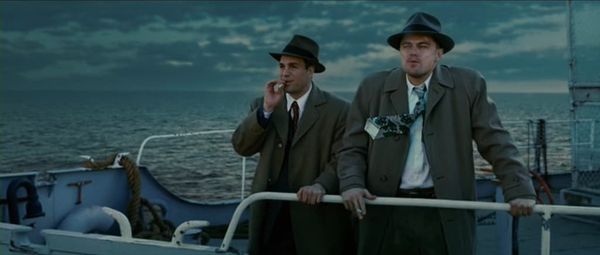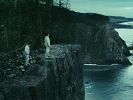Eye For Film >> Movies >> Shutter Island (2010) Film Review
Shutter Island
Reviewed by: Anton Bitel

It is 1954, in the Boston Harbour Islands. A ferryboat emerges from a thick mist, as belowdecks a man is puking his guts out. This sequence which opens Martin Scorsese's latest opus also sets the tone for what it is to follow, in a film where seemingly everything is shrouded in a fog of mystery, and an air of sickness is never far away.
The nauseous man is US Marshall Teddy Daniels (Leonardo DiCaprio), heading out on heaving waters with his new partner Chuck Aule (Mark Ruffalo) to the Ashecliffe Hospital for the Criminally Insane on Shutter Island. There he is to investigate the recent disappearance of Rachel Solando (Emily Mortimer), a deluded and dangerous filicide who seems to have vanished into thin air from her securely locked cell, leaving behind only a hidden note posing the question: "Who is 67?".

Clearly resident psychiatrists Dr Cawley (Ben Kingsley) and Dr Naehring (Max von Sydow) know more than they are saying, while just as clearly the Second World War veteran Teddy has come to Shutter Island with his own traumatic baggage and a personal agenda that extends far beyond the missing inmate. For Teddy is still haunted by the horrific death of his wife Dolores (Michelle Williams) two years ago, and he believes that her killer, the arsonist Andrew Laeddis (Elias Koteas), is hidden away somewhere in the off-limits Ward C. Yet as a powerful storm cuts the island off from all contact with the mainland, a dangerous conspiracy is about to be uncovered, layer by layer – and even Teddy, who was an eyewitness to the human horrors revealed at the liberation of Dachau, cannot quite imagine the monstrous truth buried away on Shutter Island.
Dennis Lehane has described his 2003 novel as a hybrid of the Brontë sisters' gothic writings and Don Siegel's Invasion Of The Body Snatchers (1956) – and Scorsese's film adaptation is a similar blend of tempestuous ghost story and pulpy noir, except that few Fifties B-pictures were made with such loving attention to performance and mise-en-scène.
Some viewers may feel that they are well ahead of the curve in this film's twisty narrative, but nothing can take away from Scorsese's absolute mastery of his art, so that even when one has a rough idea of where this mystery thriller is headed, the devil is in the detail, and each turn of the screw is handled with the sort of deft craftsmanship that becomes a pleasure unto itself, quite beyond the game of hermeneutic cat-and-mouse that the narrative is constantly playing with the viewer. If Scorsese is working within a prescribed genre, he is also presenting us with something that approaches its Platonic form.
If Shutter Island feels like cinema at its most quintessential, it is also deeply metacinematic. Here Scorsese brings us an ensemble of actors playing actors in a dreamworld of light and shadow where illusion and the imagination reign – and he veritably drowns his film in allusions, both visual and verbal, to other films, dressing it up in the hermetic trappings of cinema itself. Not that Shutter Island, whether the film or the place, remains entirely sealed from the realities of the outside world – for many of the tensions here derive from the historical setting of the Fifities, when the raw traumas of the Second World War were fast being overtaken by Cold War paranoia and a very different kind of war between methodologically opposed branches of psychiatry, some barbaric and some more humane.
So underlying the thick fog of fiction that Scorsese wafts over the viewer, there are some difficult truths waiting to emerge – although fantasy wins out in the end, in a manner that is as moving as it is tragic. Like any classic, Shutter Island demands to be revisited several times. Indeed, its sinuous ideas, once they have taken hold in your mind, prove difficult to escape.
Reviewed on: 25 Feb 2010




















